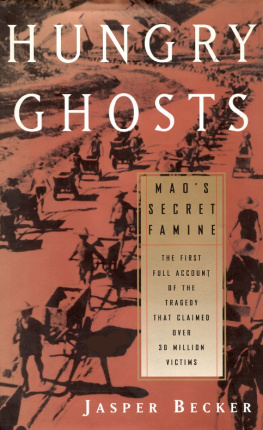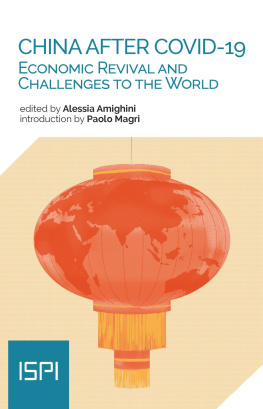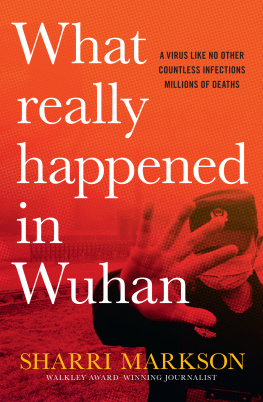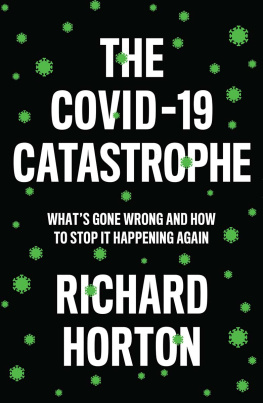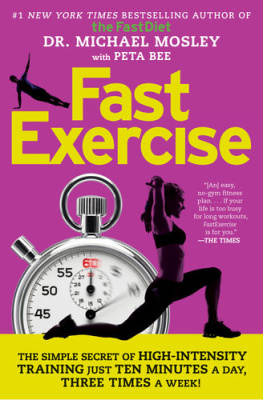Contents
Page List
Guide
MADE IN CHINA
JASPER BECKER
Made in China
Wuhan, Covid and the Quest for Biotech Supremacy
First published in the United Kingdom in 2021 by
C. Hurst & Co. (Publishers) Ltd.,
83 Torbay Road, London NW6 7DT
Jasper Becker, 2021
All rights reserved.
Printed in Scotland
The right of Jasper Becker to be identified as the author of this publication is asserted by him in accordance with the Copyright, Designs and Patents Act, 1988.
Distributed in the United States, Canada and Latin America by Oxford University Press, 198 Madison Avenue, New York, NY 10016, United States of America
A Cataloguing-in-Publication data record for this book is available from the British Library.
ISBN: 9781787384675
This book is printed using paper from registered sustainable and managed sources.
www.hurstpublishers.com
CONTENTS
1
INTRODUCTION
The pandemic began in Wuhan around mid-November 2019. Unusually large numbers of people began turning up at all the main hospitals, seeking help. They felt sick as if they had the usual winter fluonly it seemed worse. They couldnt breathe. They lost their sense of smell and taste. Rumours began to circulate that there was a new and dangerous disease spreading. A virus that is both new and lethal is a rare thing. When it was identified a few months later, people started to ask where it came from and why it started in Wuhan. This book attempts to answer those questions by looking at what happened during those first months in Wuhan in order to understand who might be responsible.
People in central China are used to getting a new winter bug each year. A new influenza virus strikes with predictable regularity in the autumn and its usually gone sometime after Spring Festival, when the weather gets warmer. So for a lot of people to go to the trouble of seeking help was not necessarily a cause for alarm, but it was the first indication that something unusual was happening.
Winter flu viruses seem to emerge from the marshes of the Yangtze Valley with its many lakes and rice paddies as if its cold dank winter climate encourages fresh mutations every year. South of the Yangtze, houses and offices are traditionally built, without heating, and people put on their woollen underwear or padded cotton pants (sometimes both) and stay indoors more. This may also be a factor.
Much about influenza viruses remains a mystery, even though they have been studied for nearly a century. In China the family of influenza viruses only began to be seriously monitored and investigated after the year 2000. There is a lot still to be discovered. We dont really know much about what sort of influenza viruses circulated in the population of China before then, or how many people they killed each year, because no one ever kept any records.
Its much easier to grasp why the COVID-19 virus might spread quickly from Wuhan. The city is located at the crossroads of China, where the Han Jiang (Han River) enters the mighty Yangtze. From Wuhan you can head upstream to Sichuan and the mountains of Tibet, or downstream to Nanjing and Shanghai. Or you can travel north up the Han River.
China is very mountainous, so it has always been easier to move goods and people from east to west along these rivers. The Ming Dynasty built an extraordinary canal (the Grand Canal) to take goods from the Yangtze Delta north to supply its capital, Beijing, and the troops manning the Great Wall. The railways made the canal redundant, and the trains heading north from Canton (now Guangzhou) terminated in Wuhan. The trains from Beijing going south, too, terminated in Wuhan. And so did the new lines running west from Shanghai and Nanjing.
A lot of people had to change trains or steamships in Wuhan, but there was nothing much to keep anyone. No charming temples, hutongs or palaces, nor shopping boulevards. Just a few warehouses and Western buildings dating from its days as a Treaty Port. It was prosperous enough, and a grand university campus had been established. All Wuhans hospitals were built, often by foreign missionaries, with funds raised by charity donations.
When I visited it in the late 1980s, Wuhan was struggling to find a new role after the delinquencies of the Mao era. It struck me as such a dismal place that I vowed never to return. For one thing, it is unbearably hot and humid in the summerit is one of the so-called Three Furnaces of Chinaand in those days no one had air conditioning. For another, it does not really have a centre or a soul. It is actually three distinct towns separated by the two wide rivers. Mao Zedong had tried to empty all the main cities and disperse the urban population to the countryside, and by the early 1960s, the state had lost interest in investing in the infrastructure of cities. In Wuhan this meant that there werent nearly enough bridges, so I spent most of my trip stuck in traffic jams just trying to get from one meeting to another.
At that time, the three parts of the city probably did not have more than a combined population of two million. Wuhan is now described as a mighty metropolis of eight million, and sometimes is even said to have eleven million, but this gives a misleading picture. Urban residents used to be described as anyone who got state rations. These days Chinas modern urban planning policy tries to prevent the key cities from growing into sprawling third-world mega cities, so instead, the fast-growing new urban population is being housed in lots of small satellite cities. So what used to be rural towns has been re-designated as part of the Wuhan metropolitan area, and this is where most of the new housing is built. And its all clusters of high-rise blocks for the masses and villa compounds for the new rich.
Almost all the residents work in the many new industrial and science parks that have been built around Wuhan. To make up for the lost years when China was preparing to survive a nuclear war, it had now lavished vast sums on new infrastructure to tie all these scattered towns and industrial parks together with new bridges, high-speed railways, airports, harbours, motorways and light railway metro systems. Everything has the shiny new look of something that has just been unwrapped.
Wuhan is not only a commercial-industrial centre, but also a defence and aerospace hub. It is home to 350 research centres and industrial institutes, as well as 1,700 companies working in the aerospace, shipbuilding and biotechnology sectors. It is here where satellites, missiles and space launchers are built.
In the 1980s, Deng Xiaopings price reforms had benefited the rural areas first. The peasants got rich selling their extra produce. For the first time in decades, they were allowed to move outside their villages without permits, if only to take their goods to sell in newly re-opened markets in the cities. Even then, they were stopped and inspected at the city boundaries as they transported their chickens or vegetables on donkey carts and bicycles. It was the first step in a gradual process by which travel became normalised.
For decades, free travel had been impossible in China, but by the time the Wuhan virus appeared, China was a nation of enthusiastic travellers and tourists. Indeed, the Chinese are the biggest single group of international travellers. Added to this, hundreds of millions travel regularly inside the country for work or pleasure. Not content with being restricted to public transport, the Chinese have been buying cars in vast numbers. China is the worlds biggest car market.


